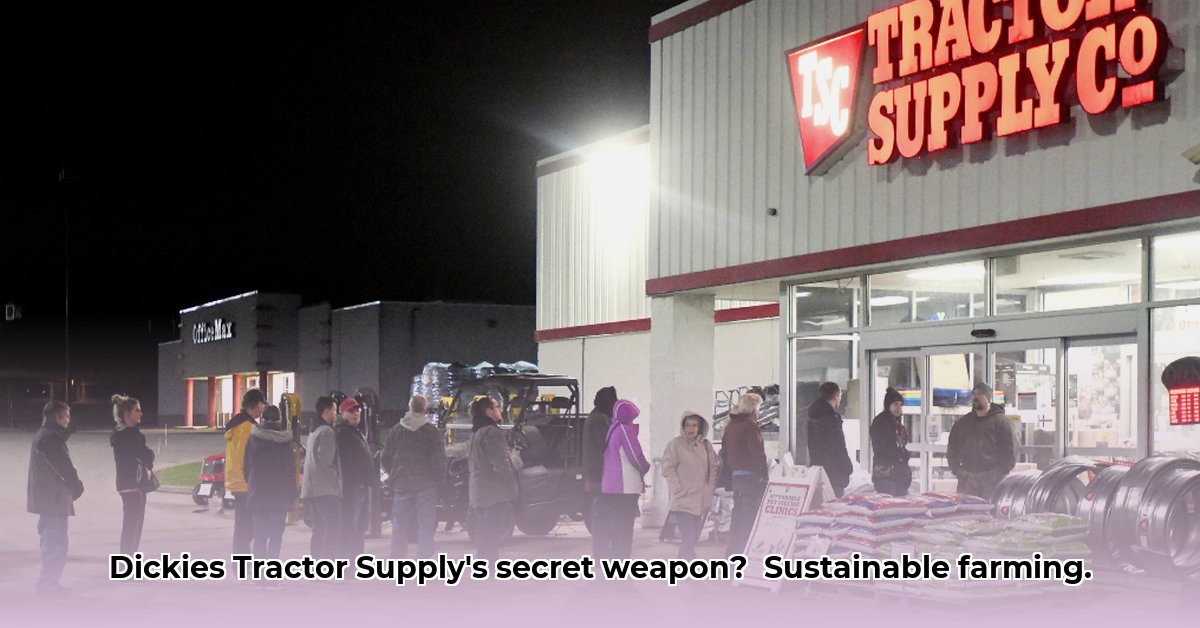
Sustainable agriculture is no longer a niche concept; it's a necessity. Feeding a growing global population while mitigating environmental impact requires innovative solutions. This article explores precision irrigation and vertical farming, two key strategies transforming the agricultural landscape, and provides actionable insights for farmers, investors, and policymakers. We will also touch upon the rising trend of organic farming and its implications. For more on sustainable farming equipment, check out Dickies Tractor Supply.
Precision Irrigation: Optimizing Water Use for Higher Yields
Precision irrigation involves delivering water precisely where and when crops need it most. This targeted approach minimizes water waste, boosting yields while conserving a precious resource. Studies show significant reductions in water consumption and substantial increases in crop output using this method. However, implementing precision irrigation systems demands considerable upfront investment and may not be suitable for all soil types.
Actionable Steps for Farmers:
- Conduct a Soil Assessment: Before investing, analyze your soil's characteristics to determine suitability for precision irrigation. Understanding your soil's drainage and water retention capacity is crucial for effective implementation.
- Pilot Program Participation: Consider participating in government-funded pilot programs offering technical assistance and financial support for testing precision irrigation technologies on a smaller scale. This minimizes risk and allows optimization before full-scale adoption.
- Data-Driven Management: Integrate soil moisture sensors and other data-gathering tools to monitor real-time conditions and precisely adjust irrigation schedules. This allows for precise water delivery and optimized resource allocation.
How can precision irrigation increase profits? Studies have shown yield increases of up to 20%, coupled with a 30% reduction in water usage. This translates directly to higher profits and reduced operational costs. What are you waiting for?
Vertical Farming: High-Density Food Production for the Future
Vertical farming, also known as stacked farming, involves growing crops vertically in multi-layered structures, often indoors. This approach offers year-round production, independent of weather conditions, and requires considerably less land than traditional agriculture. However, high capital costs and substantial energy requirements pose significant challenges.
Weighing the Pros and Cons of Vertical Farming:
| Advantages | Disadvantages |
|---|---|
| Consistent year-round yields | High initial capital investment |
| Reduced land use and water consumption | Significant energy consumption |
| Enhanced food security in urban areas | Requires specialized technical knowledge and skills |
| Minimized pest and disease risks | Ongoing maintenance and technological upkeep |
Actionable Steps for Investors and Urban Planners:
- Invest in R&D: Encourage investment in research and development to improve efficiency, reduce costs, and increase the scalability of vertical farming systems. This can open up significant opportunities in urban agriculture.
- Develop Supportive Policies: Implement policies such as tax breaks and zoning regulations that facilitate the adoption of vertical farming in urban environments. This addresses concerns surrounding land availability and encourages innovation.
- Foster Public-Private Partnerships: Encourage collaborations between public and private sectors to fund infrastructure and create sustainable vertical farming initiatives. This is key to bridging the funding gap and ensuring successful large-scale implementation.
Organic Farming: A Growing Demand for Sustainable Practices
Organic farming emphasizes natural methods, avoiding synthetic pesticides and fertilizers. Data shows a growing consumer preference for organic produce, driving increased market demand. However, transitioning to organic farming may involve temporary yield reductions and require adjustments to farming practices.
Actionable Steps for Farmers and Consumers:
- Farmers: Gradual transition to organic methods minimizes disruption, allowing for a smoother adjustment and reduced risk to farm productivity.
- Consumers: Actively supporting local organic farmers by purchasing their produce directly increases demand and incentivizes further adoption of sustainable farming practices.
Comparing and Synthesizing Sustainable Agriculture Approaches
Precision irrigation, vertical farming, and organic farming represent distinct yet complementary approaches to sustainable agriculture. The optimal strategy depends on individual circumstances, including farm size, location, available resources, and market demand. Combining these methods can create highly efficient and resilient agricultural systems.
Conclusion: Towards a Sustainable Agricultural Future
Sustainable agriculture necessitates the adoption of innovative technologies and practices. Precision irrigation and vertical farming offer powerful solutions for optimizing resource use and enhancing food production. The increased demand for organically grown produce underscores the growing consumer awareness of environmental stewardship. Dickies Tractor Supply, through its extensive network and supply chain, plays a pivotal role in supporting farmers' transition to these sustainable methods. The future of agriculture is undoubtedly sustainable, and proactive adaptation is key to ensuring long-term food security and environmental protection.
Further Resources
(Insert links to relevant websites, organizations, and publications here)